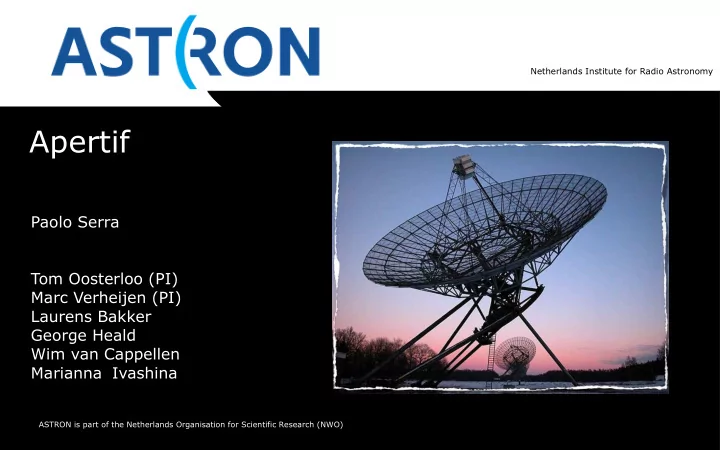

Netherlands Institute for Radio Astronomy Apertif Paolo Serra Tom Oosterloo (PI) Marc Verheijen (PI) Laurens Bakker George Heald Wim van Cappellen Marianna Ivashina ASTRON is part of the Netherlands Organisation for Scientific Research (NWO)
Outline • Instrument overview • Past results • Recent developments • Plans for data flow, reduction and archive • Science with Apertif Paolo Serra
1. Instrument overview Paolo Serra
What is Apertif? Apertif is an upgrade of the WSRT - 12 (13) 25-m dishes on an east-west array - equatorial mount - baselines from 36 m to 2.7 km Main point: replace single-pixel feeds with phased array feeds - frequency range = 1-1.7 GHz (strong GSM band below 1 GHz) - instantaneous BW =300 MHz (decision based on funding, but good for HI) - expands FOV by a factor 30, increase survey speed by a factor 60 at full BW Paolo Serra
Vivaldi array 56 x 2 receivers Paolo Serra
Survey speed EVLA Apertif MeerKat ASKAP WSRT A/T 2 1 2 0.5 1 FoV 1 30 4 120 1 Bandwidth 3 2 2 2 1 Survey Speed Shallow 4 30 16 30 1 Survey Speed Deep 12 60 32 60 1 Paolo Serra
2. Past results (“despite” LOFAR) Paolo Serra
Beginning 2008: Single dish Paolo Serra
End 2008 - 2009: compound beams Element beams are ugly... ... but compound beams are very well behaved Paolo Serra
End 2008 - 2009: interferometry with single-element Paolo Serra
2009: interferometry with compound beam offset? Paolo Serra
3. Recent developments Paolo Serra
Standing waves no more Standing waves are a problem common to all dishes Can PAFs be the solution? Paolo Serra
LNA below 10 K (Not included in current T sys ~50 K estimate for Apertif) Paolo Serra
And more on-going work... • Digestif-3 installed: - rotated elements to reduce FOV elongation • Real-time beam former (from LOFAR) • Funding proposal being evaluated by NWO (correlator, archive, pipeline, people) • Vivaldi arrays on GMRT (with LOFAR beam former); Effelsberg • Vivaldi on BETA as part of PAFSKA: - test different receivers in same conditions (dish etc.) - PAF-PAF interferometry Paolo Serra
4. Plans for data flow, reduction and archive Paolo Serra
LOFAR for Apertif LOFAR framework (it works and it’s for free!) • Real-time beam former from LOFAR - correlate with signal from all other 13 dishes - possibility of full 12-h synthesis Ideal to test compound beam stability and understand calibration needs • Adaptation of existing LOFAR calibration software to WSRT data has started LOFAR 173 MHz VLA 1.5 GHz • LOFAR archive usage starting (van Weeren) (Leahy & Perley 1991) Paolo Serra
RFI Good RFI situation - LOFAR HBA (110-250 MHz) loses only ~5% of the data Paolo Serra
5. HI Science with Apertif Paolo Serra
Apertif HI surveys - shallow all sky matching WALLABY (a few hours per pointing) - deep to z~0.25 (10x12h over 1000 sq deg) - ultra-deep to z~0.4 ? Redshift distribution deep survey -5 4 × 10 1 Apertif deep 1 x 12 hr SDSS DR5 10 x 12 hr -5 100 x 12 hr 3 × 10 -5 # 2 × 10 f 0.5 -5 1 × 10 0 0 0 20000 30000 50000 60000 70000 0 0.2 0.3 0.5 0.6 10000 40000 0.1 0.4 ! 1 ) z V hel (km s Paolo Serra
HI at z=0.2 with the WSRT 20 x 12 hr at z = 0.2 (Verheijen et al) Several dozen detections in single WSRT field Apertif is 100 times more efficient Now 100x12 hr on a single field done for this project with > 100 detections Paolo Serra
Conclusions • Apertif will expand the FOV of the WSRT by a factor 30 at 1-1.7 GHz • Compound beam properties studied in detail • First interferometry using Digestif with WSRT MFFEs • No standing waves • Digestif on GMRT, Effelsberg, BETA • Real-time beam forming and full synthesis with whole array coming soon • LOFAR architecture for calibration, archive Paolo Serra
Recommend
More recommend